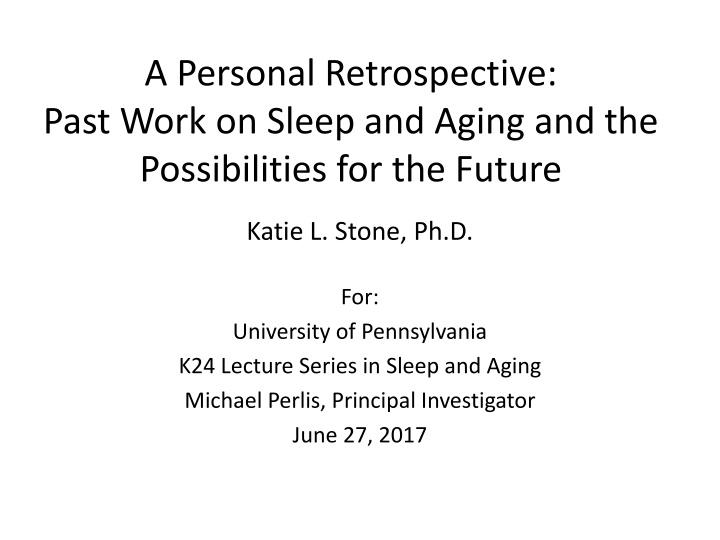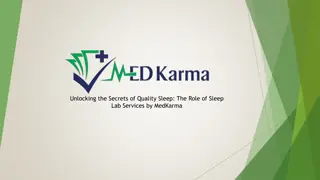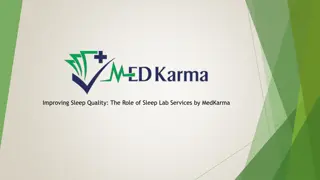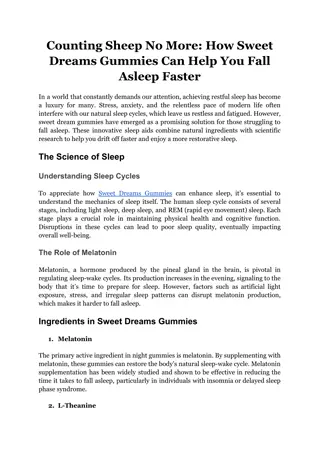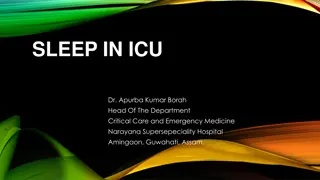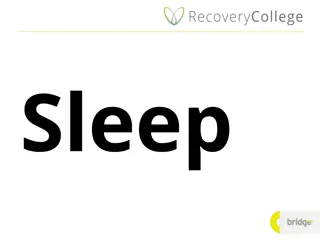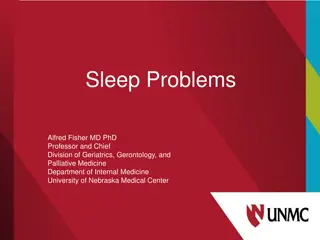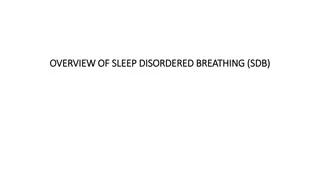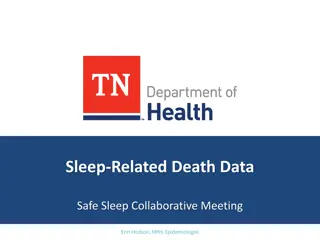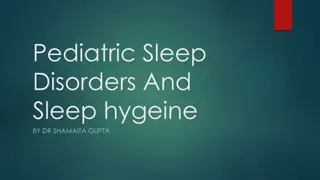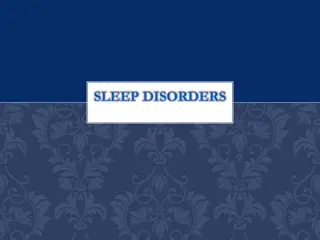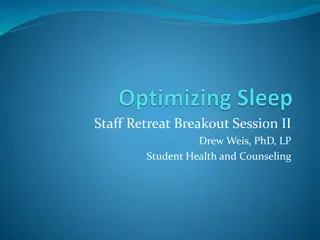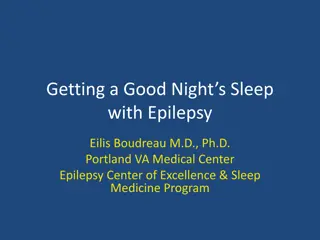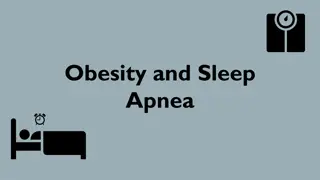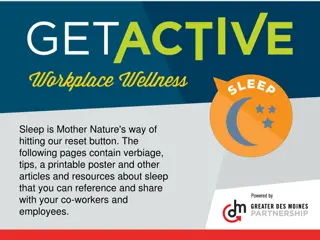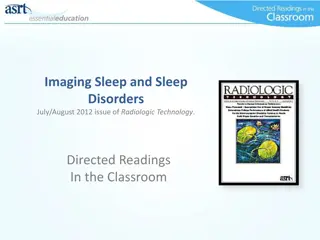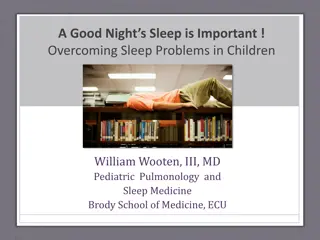Past Work on Sleep and Aging: Insights and Implications
In this personal retrospective, Dr. Katie L. Stone reflects on her journey into sleep research, highlighting the impact of disturbed sleep as a risk factor for falls and fractures. Through studies like the Sleep Debt Study, the harmful consequences of sleep deprivation on endocrine function and overall health have been revealed, drawing parallels to aging-related effects. The potential implications of addressing sleep deficits in relation to chronic diseases, cognitive decline, and other health conditions are discussed, shedding light on the importance of recognizing sleep as a vital pillar of health alongside diet and physical activity.
Download Presentation

Please find below an Image/Link to download the presentation.
The content on the website is provided AS IS for your information and personal use only. It may not be sold, licensed, or shared on other websites without obtaining consent from the author.If you encounter any issues during the download, it is possible that the publisher has removed the file from their server.
You are allowed to download the files provided on this website for personal or commercial use, subject to the condition that they are used lawfully. All files are the property of their respective owners.
The content on the website is provided AS IS for your information and personal use only. It may not be sold, licensed, or shared on other websites without obtaining consent from the author.
E N D
Presentation Transcript
A Personal Retrospective: Past Work on Sleep and Aging and the Possibilities for the Future Katie L. Stone, Ph.D. For: University of Pennsylvania K24 Lecture Series in Sleep and Aging Michael Perlis, Principal Investigator June 27, 2017
San Francisco Coordinating Center (coordinatingcenter.ucsf.edu) Non-profit academic research organization with ~ 30 years experience conducting multi-center studies and clinical trials Collaborative enterprise of the UCSF Department of Epidemiology and Biostatistics and California Pacific Medical Center Mission: to conduct high quality multi-center studies that have an impact on science, clinical practice, and public health Diverse research interests: aging sleep and circadian physical activity/function osteoarthritis biostatistics/research methods cardiovascular disease genetics osteoporosis cognitive function/dementia
My Journey Into Sleep Research Trained as biostatistician, then epidemiologist dissertation focused on diet and bone health in the elderly (SOF cohort) Measures of subjective sleep collected, had not been analyzed Disturbed sleep as a risk factor for falls and fractures? Sleep could be the third pillar of health, under- recognized compared to diet and physical activity
Van Cauter Laboratories: Sleep Debt Study* Subjects restricted to 4 hours sleep per 24hr period, for 6 consecutive days Measured endocrine function before and after sleep restriction Findings: Sleep restriction results in Glucose tolerance, thyrotropin Evening cortisol levels Activity of sympathetic nervous system * Spiegel et al, Lancet, 1999
Sleep Debt Study* Conclusions Sleep debt has a harmful impact on endocrine function Effects are similar to those seen in aging Chronic partial sleep deprivation may increase the risk of chronic diseases including Obesity Diabetes Cardiovascular disease and shorter survival Dementia/cognitive decline Etcetera *Spiegel et al, Lancet, 1999
SOF and MrOS Cohorts Large observational multi-center cohorts of community-dwelling older women (SOF) and men (MrOS) original aims focused on risk factors for osteoporosis, falls and fractures ultimately, became studies of aging in general at the time (circa 2000) there were few sleep epidemiology studies Successful R01 applications to add comprehensive measures of sleep to SOF and MrOS (funded by NIA and NHLBI)
Normal Age-Related Changes in Sleep Sleep becomes more fragmented, and shorter in total duration Alterations in sleep architecture Decreased slow wave (stages 3 & 4) sleep Longer sleep latency Alterations in circadian rhythms Increased fatigue and daytime napping
Factors Affecting Sleep in the Elderly Primary Sleep Disorders Insomnia Sleep Disordered Breathing (Sleep Apnea) Periodic leg movements in sleep Circadian rhythm disorders Medical illness Medications/polypharmacy Dementia and mood disorders Chronic pain Social factors and life events Environmental factors (e.g. lighting) Behavioral factors (e.g. physical activity, caffeine, alcohol, etc)
Insomnia Prevalence by Age Group Large-scale community survey of non-institutionalized American adults, aged 18-79 years1 50 Percent 25 0 18-34 35-49 Age Group (years) 50-64 65-79 1. Foley et al. SLEEP 1995; 18(6): 425-32
Percent with Apnea-Hypopnea Index>10, by Age Group Aged 30-60 yr1 Aged >65 yrs2 Men 15% 70% Women 5% 56% Total 10% 62% 1. Young et al NEJM 1993, 328:1230-1235; hypopnea defined as 50% +4% desat 2. Ancoli-Israel et al Sleep 1991, 14:486-495; hypopnea defined as 50%
Prevalence of Sleep Disordered Breathing (SDB) by Age, MrOS Sleep Cohort of Older Men AHI 5 prevalence is high; does not further increase with advancing age AHI 15 prevalence continues to increase with advancing age Age Mehra R et al. JAGS 55:1356 1364, 2007
Changes in Sleep Timing in Different Age Groups Sleepy Go to bed Wake up Delayed phase (teenagers) Sleepy Go to bed Wake up Standard phase (younger adults) Go to bed Wake up Advanced phase (elderly) Sleepy 6PM 9PM 12AM 3AM 6AM 9AM NOON Time of Day Wake up for school: sleep is cut short Modified from Ancoli-Israel, All I Want is a Good Night s Sleep, Mosby, 1996
Consequences of Sleep Disorders Previously, sleep loss was not believed to have any serious, long-term impact on human health Emphasis on daytime consequences, quality of life Sleep disorders previously viewed as a consequence of, rather than contributor to, poor health previous studies mostly small, cross-sectional few studies used comprehensive measures of sleep
Sleep in Older Adults Poor sleep has been associated with a variety of age- related outcomes: Cardiovascular Disease Dementia/cognitive decline Mortality Depression Diabetes Falls & Fractures Most epidemiologic studies based on a single domain e.g. sleep duration Different sleep domains and sleep disorders (e.g. sleep disordered breathing, insomnia) can impact health via different mechanisms Directionality of associations uncertain Need for longitudinal data and ultimately, interventions
Osteoporotic Fractures in Men (MrOS): PIs: Eric Orwoll (OHSU), Steve Cummings (Coord Ctr) Multi-center prospective study of risk factors for osteoporosis and osteoporotic fractures Participants recruited from population-based listings at six US clinical centers 5,995 men aged 65 and older enrolled in 2000- 2002 Ancillary study: Outcomes of Sleep Disorders in Older Men funded by NHLBI (MrOS Sleep Study, PI: K. Stone)
MrOS Sleep Study Objective assessment of sleep in ~3000 men aged 67 and older (mean age 76.4 yrs), performed in 2003-5. in-home overnight polysomnography (PSG) 5-day wrist actigraphy In-clinic examination and interview Ongoing follow-up (tri-annual questionnaire) for endpoints: Falls in previous 4 months Centrally adjudicated: fractures, deaths, cardiovascular events
Study of Osteoporotic Fractures (SOF) PI: Steve Cummings (CPMC/UCSF) Large prospective study coordinated by the San Francisco Coordinating Center Participants recruited from population-based listings at four US clinical centers 10,366 women aged 65 and older 9,704 Caucasian women recruited in 1986-88 662 African American women recruited in 1997-98
SOF Visit 8 (2002-3) Specific aims related to consequences of sleep disturbance in older women, including: - Risk of falls and fractures - Risk of total and cause-specific mortality - Cognitive and physical function In-clinic examination and interview Objective assessment of sleep using actigraphy in 3,034 women aged 70 and older (mean age 84 yrs) - PSG in a subset of 466 women (2 clinic sites)
Overview of SOF and MrOS Sleep Studies SOF MrOS Gender Female Male Age mostly 80+ 67+ #Actigraphy ~3000 ~3000 #PSG ~460 ~3000
Primary Sleep Measures: Actigraphy watch-like device worn on non-dominant wrist (somewhat like a research- grade FITBIT) Contains piezoelectric sensor to detect movements Algorithms applied to determine sleep-wake patterns over several days
Key Exposures from Actigraphy Traditional night-time sleep-wake variables (averaged over all nights of recording): Total sleep time (min) Wake after sleep onset (min) Sleep efficiency (%) Sleep latency (min) Daytime Napping behavior Rest-activity rhythms (24 hour patterns): Extended cosine model Non-parametric methods
Primary Sleep Measures: In-home single night polysomnography (Reading Center: BWH Susan Redline) 13 channels of data collection Stages of sleep and wake are determined by EEG, EMG and EOG recordings Sleep-related breathing disorders determined based on airflow and oximetry channels Periodic limb movements during sleep using leg sensor
Polysomnography: Compumedics Safiro Small & Lightweight 300 grams (9.6 ounces) w/battery Variable montage - Record up to 32 channels 144 MB flashcard storage True digital filtering during collection and review Remote monitoring all channels with desktop/notebook computer via Radio LAN Battery Power
Montage Illustrated by Kris Sodatani
Polysomnography Variables Apnea Hypopnea Index (AHI) Number of apneas + hypopneas per hour of sleep Apnea = complete cessation of airflow for 10 secs or longer + 3% (or 4%) O2 desaturation Hypopnea = partial cesstion of airflow for 10 secs or longer + 3% (or 4%) O2 desaturation Sleep disordered breathing (sleep apnea) typically defined as AHI > 5, > 10, > 15
Polysomnography Variables, continued Sleep Staging Variables % time in REM sleep, Stages 3&4, etc Oxygen saturation / nocturnal hypoxemia % time < 90% O2 saturation (or 80%) Min O2 saturation Sleep-wake variables similar to actigraphy (but only overnight) Periodic limb movement index (myoclonus index)
Subjective Sleep Measures Total Sleep Time (self-report) Pittsburgh Sleep Quality Index Epworth Sleepiness Scale Functional Outcomes of Sleep Questionnaire Insomnia Severity Index Fatigue
Selected Findings: Mortality Falls and Fractures Cognitive outcomes
Sleep Duration and Mortality Several studies have reported an association between self-reported sleep duration and mortality Increased risk among those who: Get too much sleep (e.g. 8+ hours per night) Get too little sleep (less clear) Take naps during the day Few studies have used comprehensive measures of sleep, including objective and subjective
Self-Reported 24-hour Sleep Duration and Risk of Mortality in Older Women Total Self-reported Sleep Duration and Mortality 3 <6 hrs 2.5 >6 to <8 hrs 2 Relative Risk >8 to <9 hrs (reference) >9 to <10 hrs 1.5 1 >10 hrs 0.5 0 All cause CVD Cancer Non-CVD, non- Cancer Cause of Mortality Stone et al. J Am Geriatr Soc, 2009
Actigraphic Sleep Duration and Risk of Mortality in Older Men and Women All-Cause Cardiovascular SOF women Number of deaths 997 343 Actigraphy TST <=5 hrs 1.80 (1.45, 2.23) 2.30 (1.61, 3.28) >5 to <=7 hrs 1.02 (0.88, 1.19) 1.20 (0.92, 1.57) >7 to <= 8 hrs 1.00 (referent) 1.00 (referent) >8 hrs 1.33 (1.10, 1.6) 1.43 (1.02, 2) MrOS men Number of deaths 711 198 Actigraphy TST <=5 hrs 1.49 (1.16, 1.9) 1.15 (0.73, 1.82) >5 to <=7 hrs 1.14 (0.94, 1.37) 0.88 (0.63, 1.23) >7 to <= 8 hrs 1.00 (referent) 1.00 (referent) >8 hrs 1.08 (0.80, 1.47) 0.85 (0.48, 1.51)
Nocturnal Hypoxemia and Risk of Mortality in Older Men (SaO2 < 80% > 1% vs 1% of TST) No. of Events RH (95% CI)* All Deaths 628 1.54 (1.09 2.16) Cardiovascular deaths 217 1.53 (0.88 2.68) Cancer deaths 171 2.30 (1.35 3.92) Other (non-cancer, non-CVD) 240 0.81 (0.37 1.28) *Adjusted for age, clinic site, race, BMI, depression, cognition, alcohol use, education, smoking, caffeine, physical activity, chronic disease, medications Smagula, Stone et al. Psychosom Med 2016; 78(6): 686 96)
Activity Rhythms and Survival Strong Weak 4 3 Log of Activity Score (PIM) 2 1 0 0 12 24 36 48 60 72 84 96 108 Clock Time
Activity Rhythms and Survival Strong Strong Weak Weak 4 3 Log of Activity Score (PIM) 2 1 Tranah et al, 2010, J Am Geriatr Soc 0 0 12 24 36 48 60 72 84 96 108 Clock Time
Shifted rhythms Late 9:05AM 1:40AM Mean 7:11AM 11:18PM Early 5:55AM 10:07PM 2:40PM 3:50PM 1:30PM Time of Day Peak
5 year mortality Cancer Stroke 2.1 (1.1-4.2) Late 2.6 (1.1-6.3) Mean 1.0 1.0 Early 1.0 (0.42-2.6) 2.3 (0.95-5.4) 3:50PM 1:30PM Tranah et al, 2010, J Am Geriatr Soc
Selected Sleep Health Predictors REPRESENTATIVE SLEEP HEALTH CHARACTERISTICS SLEEP HEALTH DOMAINS Actigraphy Mean Total Sleep Time DURATION TIMING Actigraphy Mean Sleep Midpoint CONTINUITY Actigraphy Mean Wake After Sleep Onset QUALITY PSQI Sleep Quality Item SLEEPINESS Epworth Sleepiness Scale (ESS) RHYTHMICITY Pseudo-F (Fit of Cosine to Actigraphy ) REGULARITY Actigraphy St. Dev. Wake Time Created categorical versions to indicate extreme sleep characteristics Computed number of extreme characteristics Random Survival Forest analysis
Which Sleep Health Characteristics Predict Mortality in Older Men? VIMP or Predictor Relative to VIMP of Age X 100 All sleep information considered jointly Rhythmicity Continuity # Extreme Characteristics Duration Timing Sleepiness Quality Regularity
Characteristics of Sleep and Risk of Falls and Fractures
Sleep and Falls Falls occur in approximately a third of community- dwelling older adults each year >50% of institutionalized elders fall each year Major cause of disability and mortality Evidence suggests increased fall risk in older adults with sleep problems Poor sleep may represent a potentially modifiable risk factor to reduce risk of falls
Sleep and Falls, continued Controversy: is it the sleep problem, or medications (e.g. hypnotics) used to treat the sleep problem that is responsible for increased fall risk? Most studies did not examine the independent effects of disturbed sleep and medications used to treat sleep Clinical trials assessing pharmaceutical interventions for insomnia have not been designed with power to test effects of treatment on risk for falls
Actigraphic measures of nightly sleep duration and risk of falls in older women1 (SOF) Risk of falls* n=2,978, mean age=83y 2 Odds ratio (95% CI) Reference 1 0 <=5 >5 to 7 Sleep duration (hours) >7 to 8 >8 1. Stone KL et al. Arch Int Med 2008; 168(16): 1768-75. * Falls were ascertained by tri-annual questionnaire. 549 women (18.4%) suffered 2+ falls during approximately one year after sleep assessment. Results adjusted for age, race, BMI, depression, exercise, instrumental activities of daily living, comorbidities, cognitive function, and use of benzodiazepines and antidepressants.
Actigraphic measures of sleep and risk of falls in older women1 (SOF), additional results Results between sleep duration and fragmentation and risk of falls were unchanged by adjustment for benzodiazepine use Use of short-acting benzodiazepines was associated with increased risk of frequent falls, even after accounting for objectively measured sleep OR=1.53, 95% CI=1.00 2.32 1. Stone KL et al. Arch Int Med 2008; 168(16): 1768-75.
Non-benzodiazepine sedative hypnotics and risk of falls & fractures Newer Z drugs believed to be safer because of shorter half life Few studies (no trials) of these drugs and risk of falls and fractures . However so far it is not looking good! Zolpidem is a commonly prescribed insomnia medication in the elderly
Use of non-benzodiazepine hypnotics and risk of falls in older men Clinic Visit during 2007-2009 Among 4450 older men: 97 reported using non-benzodiazepine hypnotics - 84 zolpidem - 3 zaleplon - 10 eszopiclone Incident falls in the subsequent year after the clinic visit were ascertained by self-report - Any falls (at least 1 fall during the subsequent year) - Recurrent falls (2 or more falls during the subsequent year) Diem et al, 2014, J Gerontol Geriatr Res.
Use of non-benzodiazepine hypnotics and risk of falls in older men* 3 2 Relative Hazard 1 0 Any Fall Recurrent Fall Any Fall, No history of falls *Adjusted for age, site, GDS score, educational status, BMI, comorbidity index, ability to stand from a chair, PASE score, self-reported health status, IADL impairments, alcohol use, and MMSE Diem et al, 2014, J. Gerontol Geriatr Res.
Later Acrophase Associated with Increased Recurrent Fall Risk in Older Men ( 2 falls vs < 2 falls in the subsequent year) No. of Events OR (95% CI)* Early (< 1pm) 52 0.86 (0.62, 1.20) Normal (reference) 282 1.0 Late (> 3:30pm) 83 1.46 (1.08, 1.97) *Multivariate adjusted model Rogers et al. Osteoporos Int 2017; 28: 1313-1322
